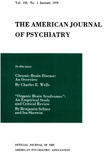Parental, Birth, and Infancy Factors in Infant Twin Development
Abstract
This report, part of a longitudinal study of ten pairs of twins, delineates personality differences that appear in the first year of life, especially in the areas of dependence-independence, emotionality, sociability, curiosity, and activity-passivity. Other variables that differentiate twins include: birth order, birth size, neurological competence, occurrence of a significant traumatic experience, parental "linkage," and physical development. The findings are discussed in relation to studies of normal development and studies of adult twins discordant for schizophrenia. Although twinship is a special circumstance, the authors believe that the observations of this study are probably valid for personality development in general—more obviously with siblings or dizygotic twins, more subtly with the only or firstborn child.
Access content
To read the fulltext, please use one of the options below to sign in or purchase access.- Personal login
- Institutional Login
- Sign in via OpenAthens
- Register for access
-
Please login/register if you wish to pair your device and check access availability.
Not a subscriber?
PsychiatryOnline subscription options offer access to the DSM-5 library, books, journals, CME, and patient resources. This all-in-one virtual library provides psychiatrists and mental health professionals with key resources for diagnosis, treatment, research, and professional development.
Need more help? PsychiatryOnline Customer Service may be reached by emailing [email protected] or by calling 800-368-5777 (in the U.S.) or 703-907-7322 (outside the U.S.).



